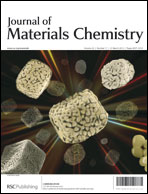In organic light-emitting devices, materials with efficient electron-transporting properties, are essential. In this report, oxadiazole-containing tetraphenylethene TPE-Oxa is synthesized and its optical physics and electronic properties are investigated. The dye is almost nonluminescent when molecularly dissolved in solutions, but becomes highly emissive when aggregated in poor solvents or fabricated as thin films in the solid state. A quantum yield of unity has been achieved in its solid thin film. Inherited from the oxadiazole component, the dye molecule enjoys low-lying electronic band energies. Benefiting from the good electron-transporting and hole-blocking properties of the dye, the two-layer OLED devices using TPE-Oxa as both light-emitting and electron-transporting materials show superior performance, i.e., lower turn-on voltage, higher brightness and efficiencies, to the devices of typical configuration with a dedicated electron-transporting layer.
You have access to this article
 Please wait while we load your content...
Something went wrong. Try again?
Please wait while we load your content...
Something went wrong. Try again?


 Please wait while we load your content...
Please wait while we load your content...